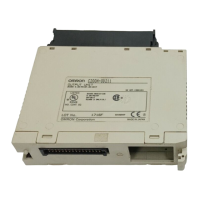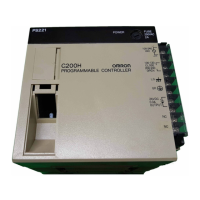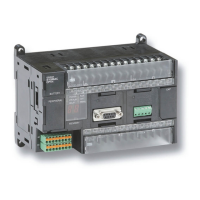55
When the execution condition for the first IL(02) is OFF, TIM 11 will be reset
to 1.5 s, CNT 01 will not be changed, and 0502 will be turned OFF. When the
execution condition for the first IL(02) is ON and the execution condition for
the second IL(02) is OFF, TIM 11 will be executed according to the status of
0001, CNT 01 will not be changed, and 0502 will be turned OFF. When the
execution conditions for both the IL(02) are ON, the program will execute as
written.
5–8 Jump and Jump End – JMP(04) and JME(05)
Ladder Symbols
JMP(04) JME(05)
A maximum of eight jumps are allowable in any program.
JMP(04) is always used in conjunction with JME(05) to create jumps, i.e., to
skip from one point in a ladder diagram to another point. JMP(04) defines the
point from which the jump will be made; JME(05) defines the destination of
the jump. When the execution condition for JMP(04) in ON, no jump is made
and the program is executed as written. When the execution condition for
JMP(04) is OFF, a jump is made to the the JME(05) with the same jump
number and the instruction following JME(05) is executed next.
Jumps, when made, will go immediately from JMP(04) to JME(05) without
executing any instructions in between. The status of timers, counters, bits
used in OUT, bits used in OUT NOT, and all other status controlled by the
instructions between JMP(04) and JME(05) will not be changed. As all of the
instructions between JMP(04) and JME(05) are skipped, jumps can be used
to reduce scan time.
Although DIFU(13) and DIFD(14) are designed to turn ON the designated bit
for one scan, they will not necessarily do so when written between JMP(04)
and JMP (05). Once either DIFU(13) or DIFD(14) has turned ON a bit, it will
remain ON until the next time DIFU(13) or DIFD(14) is executed again. In
normal programming, this means the next scan. In a jump, it means the next
time the jump from JMP(04) to JME(05) is not made, i.e., if a bit is turned ON
by DIFU(13) or DIFD(14) and then a jump is made that skips the DIFU(13) or
DIFD(14), the designated bit will remain ON until the next time the execution
condition for the JMP(04) controlling the jump is ON.
When JMP(04) and JME(05) are not used in pairs, an error message will ap-
pear when the program check is performed. Although this message also ap-
pears if JMP(04) 00 and JME(05) 00 are not used in pairs, the program will
execute properly as written.
The High-speed Counter (HDM(98) should not be used within a
JMP(04)–JME(05) portion of the program.
There are no flags affected by these instructions.
Examples of jump programs are provided in
4–3–5 Jumps
.
Limitations
Description
DIFU(13) and DIFD(14) in
Jumps
Precautions
Flags
Examples
Jump and Jump End Section 5–8

